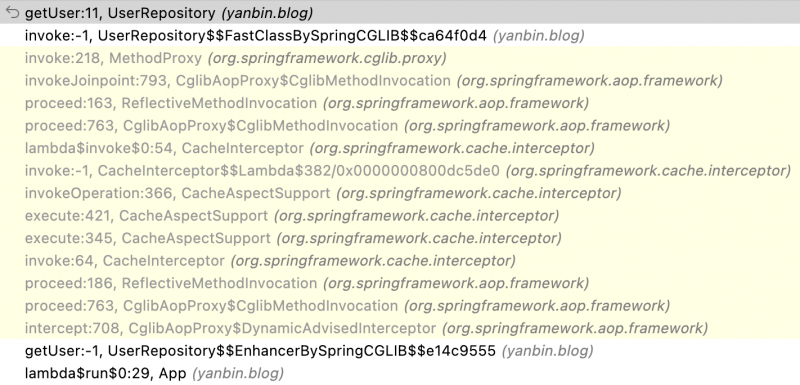

Spring 使用 Cache 解析及使用不同类型的 Cache
source link: https://yanbin.blog/spring-cache-different-cache-types/
Go to the source link to view the article. You can view the picture content, updated content and better typesetting reading experience. If the link is broken, please click the button below to view the snapshot at that time.

Spring 使用 Cache 解析及使用不同类型的 Cache
2022-07-14 — Yanbin
要在一个 Spring 应用中开启缓存方法返回结果的功能很简单,不需要额外的依赖,相关的的注解 @Cacheable, @CacheConfig, @CachePut, @CacheEvict, @EnableCache 等来自 spring-context 包。默认的的 Cache 实现是把数据存入到 ConcurrentMap 中,所以数据一直在内存中,除非显式的调用被 @CacheEvict 的方法来清理。实际进行数据缓存时会有更复杂的策略,如元素个数,占用内存,过期时间,何时使用磁盘等,而且不同的数据类型应有不同的缓存策略。
因此,除了使用默认的 ConcurrentMap 作为缓存外,还可通过配置属性 spring.cache.type 来使用其他类型的缓存,如 Caffeine, Couchbase, EhCache, INfinispan, JCache, Redis 等,或自定义 CacheManager 来使用 Guava Cache。
先来看来简单使用 Spring Cache 的步骤
假设我们调用 UserRepository.getUser(id) 方法, id 相同的话首先取缓存中的数据,UserRepository 的代码如下
@Repository public class UserRepository { @Cacheable("users") public User getUser(String id) { System.out.println("load user by id from database"); return new User(id, "Yanbin", "anywhere"); |
我们首先心里要清楚, @Cacheable 是通过代理的方式生效的,代理在调用 getUser(id) 之前检查缓存中是否有相应的数据,有则不调用 getUser(id) 方法,否则调用,并把结果存入缓存以备用。因为要实现代理,所以 @Cacheable 注解方法所在的实例必须是一个 Spring Bean, 而且要从外部调用 getUser(id) 方法。
现在来使用缓存,代码写在 App 类中
@SpringBootApplication @EnableCaching public class App implements ApplicationRunner { @Autowired private UserRepository userRepository; public static void main(String[] args) { SpringApplication.run(App.class, args); @Override public void run(ApplicationArguments args) throws Exception { IntStream.range(0, 3).forEach(i -> System.out.println(userRepository.getUser("001")) System.out.println(userRepository.getUser("002")); System.out.println(userRepository.getUser("001")); |
运行结果如下:
load user by id from database
yanbin.blog.User@54ec8cc9
yanbin.blog.User@54ec8cc9
yanbin.blog.User@54ec8cc9
load user by id from database
yanbin.blog.User@1edb61b1
yanbin.blog.User@54ec8cc9
相同的 id 后缓都是从缓存中获得数据而不用实际调用 getUser(id) 方法。
再次强调 Spring Cache 生效的几个必要条件
- @EnableCaching 启用缓存,否则 @Cacheable 等注解不产生任何作用
- 被 @Cacheable 注解方法所在实例必须是一个 Spring Bean, 直接用 new UserRepository().getUser("001") 不会使用缓存
- 被 @Cacheable 注解的方法必须从外部调用,否则不会经过代理。UserRepository.foo() 方法调用 getUser("001") 也不会使用缓存
如果打个断点,就能看到在正常的调用栈之间添加了很多步骤
解析 Spring Cache 的实现
在我们使用 @EnableCaching 后,将会引入 SimpleCacheConfiguration, 在其中会调用 new ConcurrentMapCacheManager() 创建一个 CacheManager, 该 CacheManager 在用 @Cacheable(cacheNames="users") 检测到没有相应的 users 缓存实例 则会创建它,等于缓存是动态创建的。缓存是通过 ConcurrentMapCacheManager.createConcurrentMapCache(name) 创建的,是一个 ConcurrentHashMap 实例。
缓存数据的分类就是通过 @Cacheable 的 cacheNames 参数达成的,比如
@Cacheable("users")
public User getUser(String id);
@Cacheable("roles")
public User getRole(String roleId);
@Cacheable 的 cacheNames 还能指定数据同时存储到多个 cache 中去。
Spring Cache 其他相关的概念可在 @CacheConfig 中看到
- keyGenerator: cache key 的生成器,默认为 SimpleKeyGenerator,把方法的所有参数进行 hash 得到一个 key
- cacheManager: 可以定义自己的 cacheManager, 默认为 ConcurrentMapCacheManager
- cacheResolver: @Cacheable 可根据条件来选择对应的 cache,默认为 SimpleCacheResolver
当 Spring 在调用 @Cacheable("users") 之前,会从配置的 cacheManager 由 users 获得相应的 cache, 如 ConcurrentMapCacheManager 的方法
public Cache getCache(String name) { Cache cache = this.cacheMap.get(name); if (cache == null && this.dynamic) { synchronized (this.cacheMap) { cache = this.cacheMap.get(name); if (cache == null) { cache = createConcurrentMapCache(name); this.cacheMap.put(name, cache); return cache; |
有 users 对应的 Cache 就直接用,没有就调用 createConcurrentMapCache() 动态创建一个
从以上我们大概知道 Spring Cache 有哪些扩展点,keyGenerator, cacheManager, cacheResolver, 还有 CacheManagerCustomizer。@Cacheable和 @CachePut 的 key 属性还能使用 SpEL 表达式来选择 key, 如
@CachePut(value="users", key="#result.id") User getUser(String id, String condition) |
支持的属性有 #root.args, #root.caches, #root.target, #root.targetClass, #root.method, #root.methodName, #result, #Arguments
另外,我们主要聚焦 @Cacheable 注解,它还有 condition, unless 和 sync 来控制缓存的条件和是否同步存取缓存数据(默认为 false)
自定义不同的缓存实现
系统中不同类型的数据我们需要配置不一样的缓存策略,这就要对缓存进行定制,有多种式
- 定义不同的 cacheManager, 在 @Cacheable 中通过 cacheManager 选择。多个 cacheManager 时须标明一个是 @Primary
- 自定义 cacheResolver, 在 @Cacheable 中指定 cacheResolver 属性,根据条件选择哪个 CacheManager
- 自定义 cacheManager, 在 cacheManager 中根据 cacheName 来选择不同的 Cache. 本人倾向于这种方式
后面的示例用到了 Guava Cache 实现,所以需先引入它
<dependency> <groupId>com.google.guava</groupId> <artifactId>guava</artifactId> <version>31.1-jre</version> </dependency> |
自定义多个 cacheManager
@Configuration public class AppConfig { @Bean @Primary public CacheManager rolesCacheManager() { return new ConcurrentMapCacheManager("roles"){ public Cache createConcurrentMapCache(String name){ return new ConcurrentMapCache(name, CacheBuilder.newBuilder() .expireAfterWrite(5, TimeUnit.MINUTES).maximumSize(2).build().asMap(), false); @Bean public CacheManager usersCacheManager() { return new ConcurrentMapCacheManager("users"){ public Cache createConcurrentMapCache(String name){ return new ConcurrentMapCache(name, CacheBuilder.newBuilder() .expireAfterWrite(10, TimeUnit.MINUTES).maximumSize(1).build().asMap(), false); |
在 UserRepository.getUser(id) 的 @Cacheable 需选择 cacheManager="usersCacheManager"
@Cacheable(value = "users", cacheManager = "usersCacheManager") public User getUser(String id) { |
如果不指 cacheManager, 将会使用默认(@Primary) 的 rolesCacheManager, 它没有 users cache, 所以会报错
Cannot find cache named 'users' for Builder ....
如果不标明一个 cacheManager 是 @Primary, 启动时会报错
No qualifying bean of type 'org.springframework.cache.CacheManager' available: expected single matching bean but found 2: rolesCacheManager,usersCacheManager
usersCache 设置最多一个元素,所以执行相同 App 的输出为
load user by id from database
yanbin.blog.User@54ec8cc9
yanbin.blog.User@54ec8cc9
yanbin.blog.User@54ec8cc9
load user by id from database
yanbin.blog.User@503d56b5
load user by id from database
yanbin.blog.User@72bca894
存入 002 后, 011 被驱逐出去了,所以再次调用 getUser("001") 又重新创建了一个新的元素,而非来自于缓存中
自定义 CacheResolver
在上面定义了 usersCacheManager 和 rolesCacheManager 两个 Bean 的 AppConfig 中再加上一个 Bean
@Bean public CacheResolver myCacheResolver(List<CacheManager> cacheManagers) { return context -> { Collection<Cache> caches = new ArrayList<>(); cacheManagers.forEach(cacheManager -> { cacheManager.getCacheNames().forEach(cacheName -> { if(context.getOperation().getCacheNames().contains(cacheName)) { caches.add(cacheManager.getCache(cacheName)); return caches; |
根据注解 @Cacheable 中的 cacheNames 中定位到需要的 Cache
然后在 @Cacheable 中指定 cacheResolver="myCacheResolver"
@Cacheable(value = "users", cacheResolver = "myCacheResolver") public User getUser(String id) { |
执行效果保持一至
自定义 cacheManager
这种方式我们只需要定义一个 cacheManager, 也不用 cacheResolver, 在 AppConfig 中的 Bean 定义为
@Configuration public class AppConfig { @Bean public CacheManager cacheManager() { Map<String, Cache> cacheMap = Stream.of( new ConcurrentMapCache("users", CacheBuilder.newBuilder() .expireAfterWrite(10, TimeUnit.MINUTES).maximumSize(1).build().asMap(), false), new ConcurrentMapCache("roles", CacheBuilder.newBuilder() .expireAfterWrite(5, TimeUnit.MINUTES).maximumSize(10).build().asMap(), false)) .collect(Collectors.toMap(ConcurrentMapCache::getName, c->c)); return new CacheManager() { @Override public Cache getCache(@Nonnull String cacheName) { return cacheMap.get(cacheName); // 根据 cacheName 选择 Cache @Override @Nonnull public Collection<String> getCacheNames() { return cacheMap.keySet(); |
这个 cacheManager 将会替代原本默认的 ConcurrentMapCacheManager, 所以使用时不用指定 cacheManager,只要告诉 cacheName
@Cacheable(value = "users") public User getUser(String id) { |
系统中的 Cache 还是有所限制的好,不能无限的创建,容易导致问题,比如两个从不同数据源取 user 的 getUser(String id), 因为写错了 cacheName 就会造成性能的下降
DbUserRepository
@Cacheable(value = "user") public User getUser(String id) { |
S3UserRepository
@Cacheable(value = "users") public User getUser(String id) { |
这将会导致调用某一个 getUser(id) 方法时无法共享另一个 getUser(id) 的结果,因为 user 和 users 会分别创建两个 Cache。如果 CacheManager 中限定了不只有 users 时,则 Spring 在处理 @Cacheable(value="user") 会报告找不到 user Cache 的错误。
其他高级话题
Spring Cache 默认时使用 ConcurrentHashMap 来缓存数据,不能设置额外的缓存策略。通过自定义 CacheManager 可以设定自己的缓存策略,或者使用第三方的 Spring 已提供的实现配置,如 Caffeine, Redis 等,当然需要引入相应的缓存实现依赖。
通过声明一个继承自 CachingConfigurerSupport 的 Spring Bean, 可为 Spring Cache 提供默认的 CacheManager, CacheResolver, KeyGenerator, 和 CacheErrorHandler.
Recommend
About Joyk
Aggregate valuable and interesting links.
Joyk means Joy of geeK
